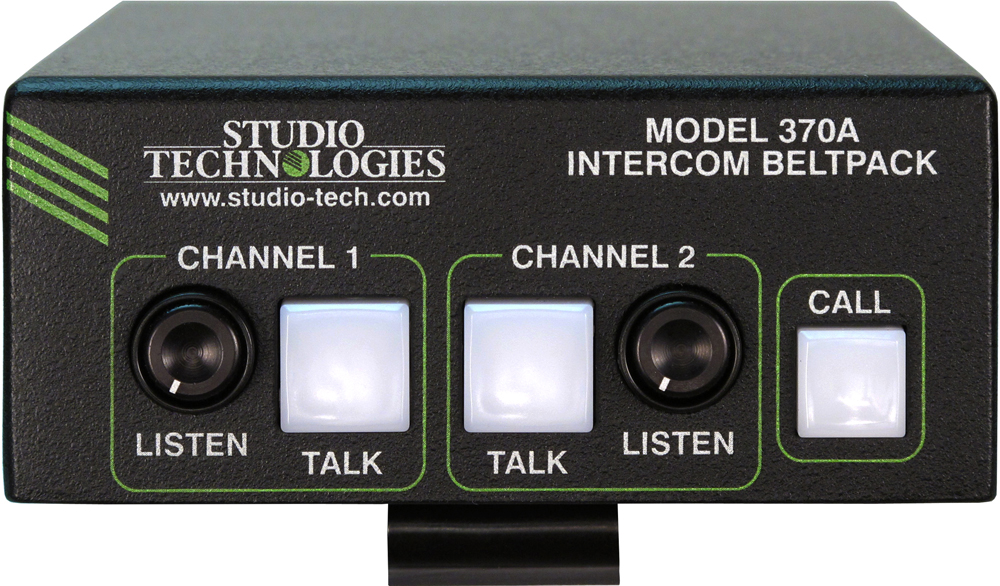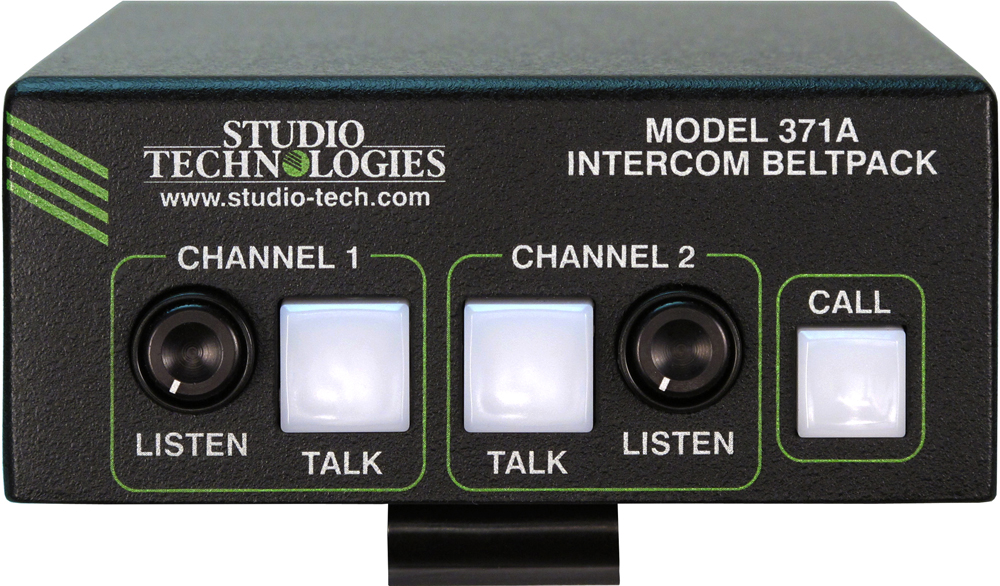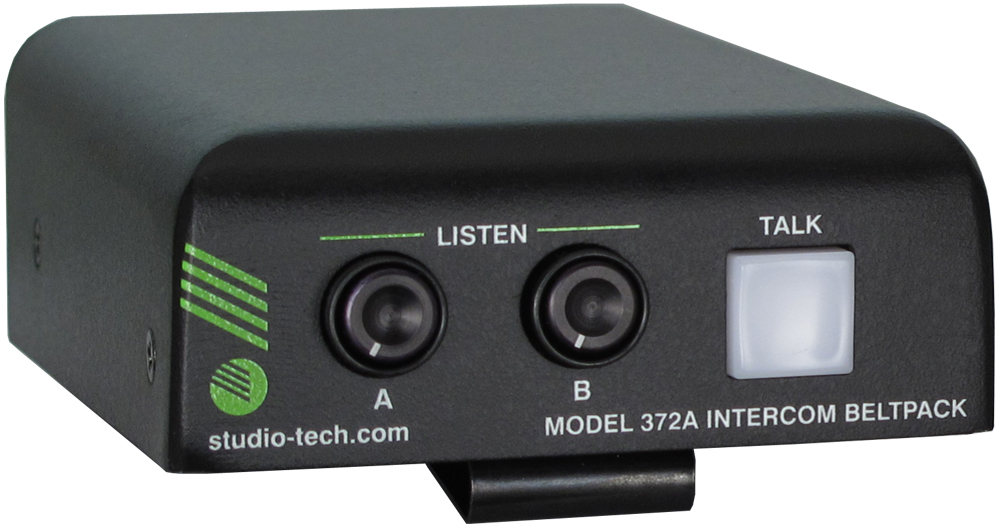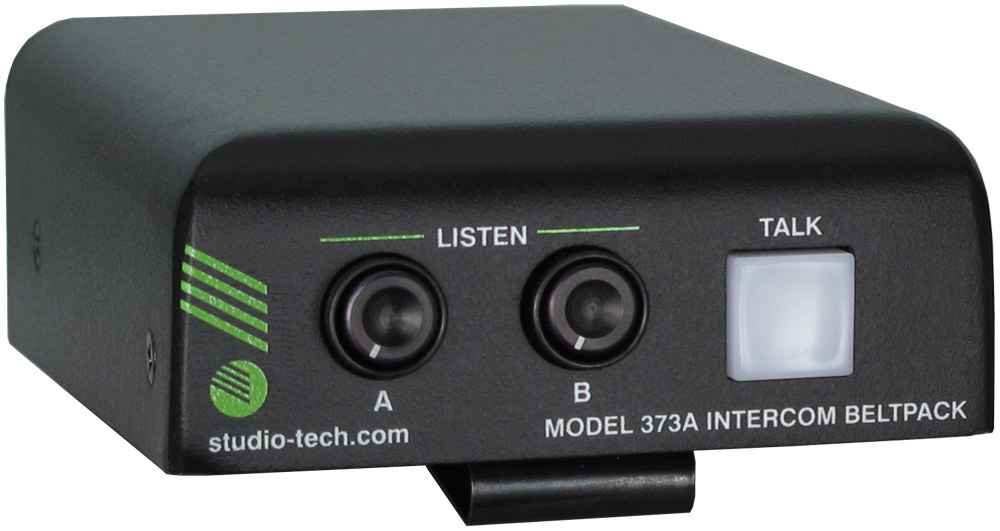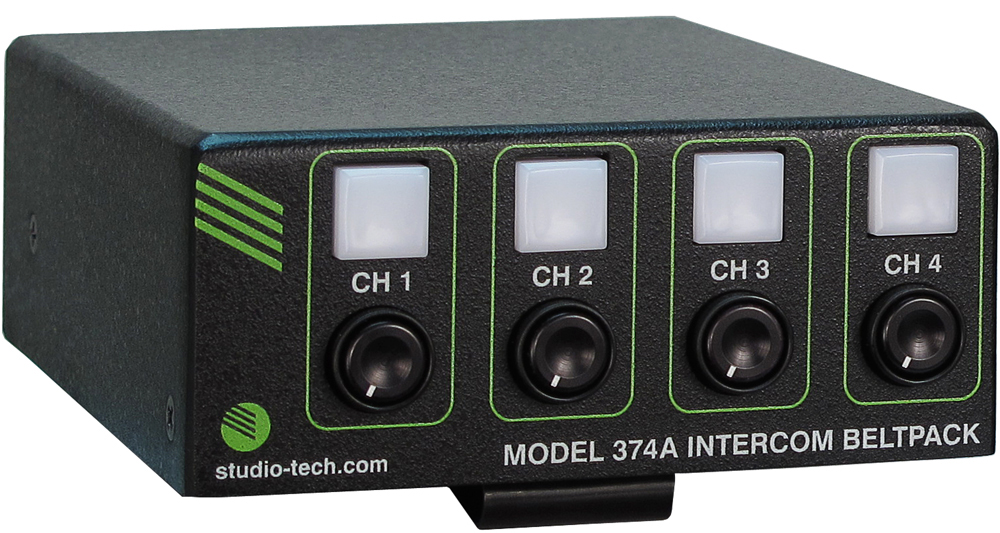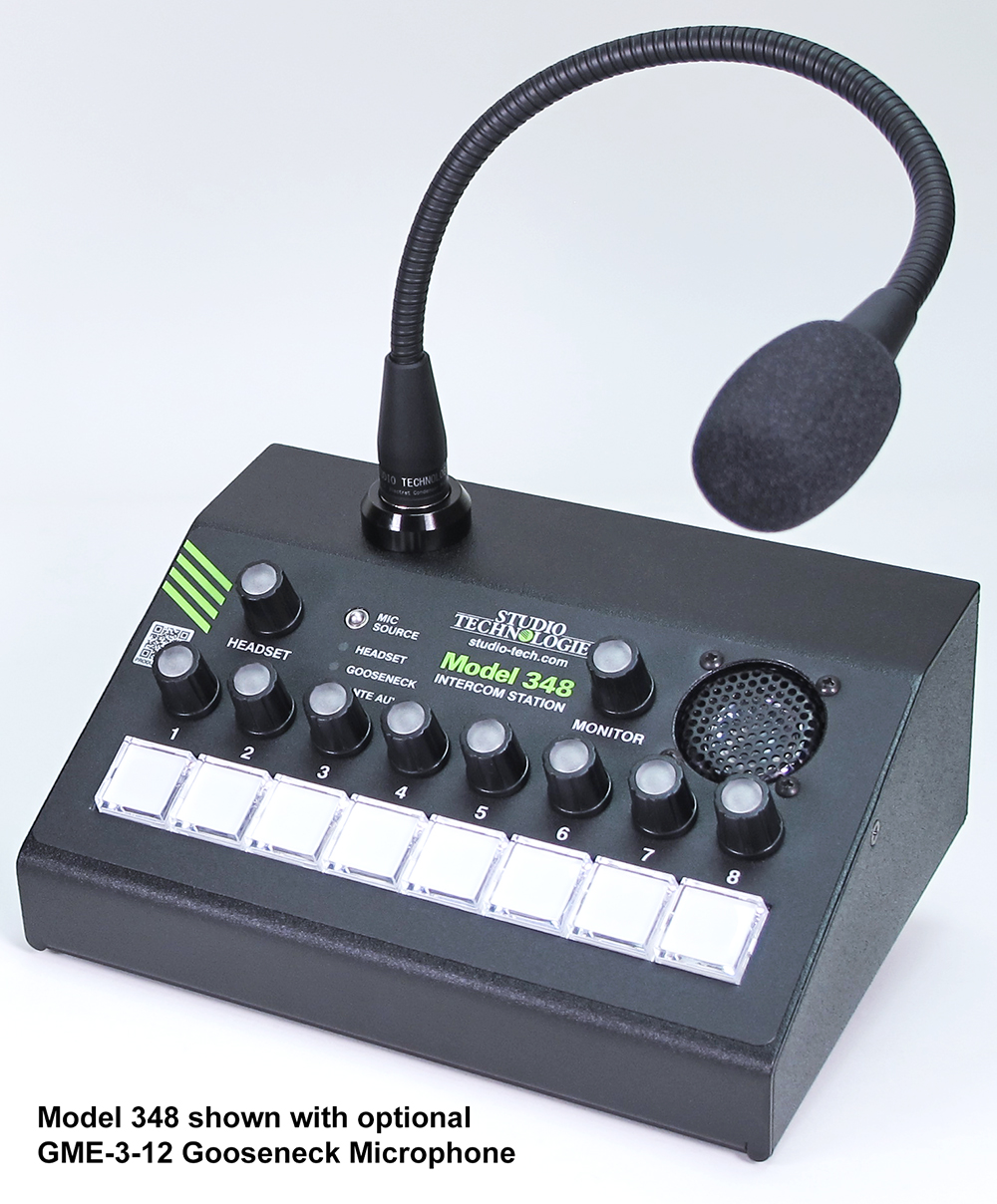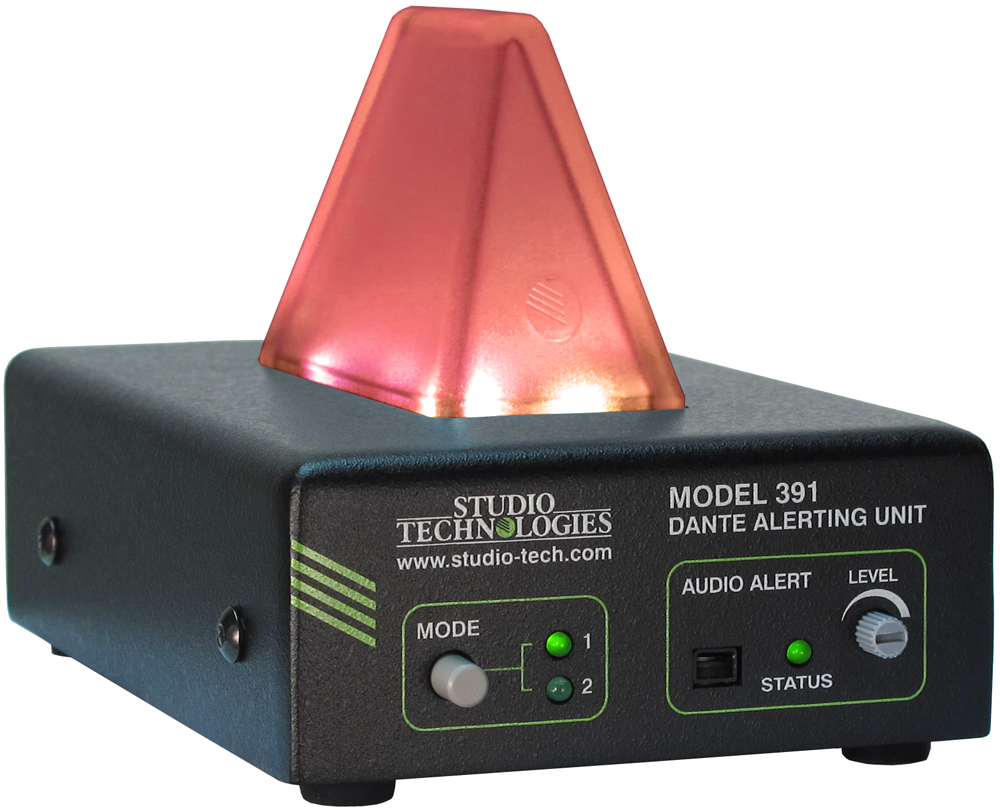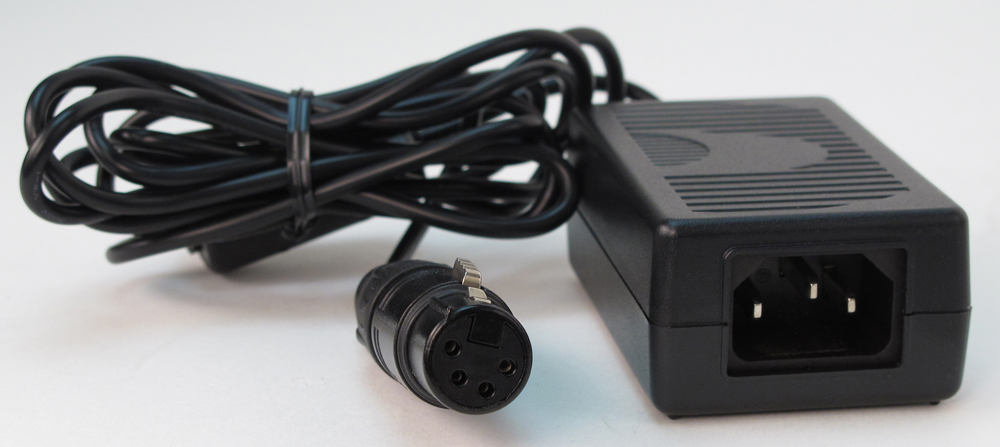The Model 5422A Dante Intercom Audio Engine is a high-performance, cost-effective, and flexible solution for creating party-line (PL) intercom circuits when used with Dante®-compatible products. These include the Studio Technologies' range of 1-, 2-, and 4-channel intercom beltpacks. The Model 5422A will also prove value in a variety of other general audio and broadcast-related mixing, IFB (talent cuing), and interfacing applications. The unit is suitable for use in fixed and mobile broadcast facilities, post-production studios, commercial and educational theater environments, and entertainment applications. Only power and Ethernet network connections are required for the Model 5422A to provide a powerful resource in a variety of Dante applications. The Model 5422A is available in two versions — one with 32 input and output channels and the other with 64 input and output channels.
The Model 5422A provides three Gigabit Ethernet (GbE) network interfaces, two which can support redundant Dante operation and a third for accessing the management menu system. To meet the latest interoperability standard the unit's Dante implementation meets the requirements of AES67. Support for the Dante Domain Manager™ (DDM) software application is also provided. An integral web server allows fast and flexible configuration of the unit's audio, networking, and Dante performance. Front-panel indicators, a graphics display, and pushbutton switches provide personnel with direct access to key operating parameters. Using the STcontroller software application, key operating parameters can be monitored in real time. In addition, STcontroller allows direct access to the Model 5422A's management webpages.
The Model 5422A can be powered by 100-240 V, 50/60 Hz AC mains or a source of 12 volts DC. The lightweight enclosure mounts in one space (1U) of a standard 19-inch rack.
Applications
The Model 5422A is compatible with many Dante-compliant devices including the extensive range of intercom beltpacks from Studio Technologies. These include the single-channel/dual-listen Model 372A and Model 373A, the 2-channel Model 370A and Model 371A, and the 4-channel Model 374A. The Model 5422A will also function directly with other Dante-supporting devices such as the Model 348 Intercom Station, Model 5304 Intercom Station, and Model 391 Dante Alerting Unit. In addition, the Model 5422A can function with matrix intercom systems, audio consoles, and wireless intercom base stations.
Pro Audio Quality and Auto Mix
The Model 5422A supports 48 kHz sampling rate digital audio signals that interface using Dante. The unit's audio circuitry was designed to meet the demands of professional audio applications, far exceeding the sonic quality of "typical" intercom products. A bit depth of up to 32 is supported and all audio processing is performed using high-speed 32-bit programmable logic. This ensures that the audio performance is excellent, providing the expected benefits of minimal distortion, low noise, high headroom, flat frequency response, and extremely low latency.
The Model 5422A's Auto Mix function utilizes a sophisticated FPGA-based algorithm to provide enhanced audio intelligibility. This feature is unique to party-line (PL) intercom applications and offers users the opportunity to obtain the absolutely finest audio performance. Studio Technologies is confident that the Model 5422A's Auto Mix capability will meet or exceed the automatic mixer performance of virtually all other hardware- or software-based devices.
Two Versions
Two versions of the Model 5422A are available. The Model 5422A-01 provides one 32-channel audio engine. The Model 5422A-02 provides two 32-channel audio engines for a total of 64 input and output channels. The size and scope of a specific application will dictate which Model 5422A version is applicable. The term "audio engine" was selected to describe a set of audio input, processing, routing, and output resources that can be configured to support specific intercom, talent-cueing, and audio routing and control functions. Unlike general-purpose digital matrix devices, the Model 5422A is optimized to allow direct support for these special broadcast and general-intercom applications.
Group Configuration
Configuration choices select how each 32-channel audio engine is segmented, labeled (named), and optimized for how the associated audio signals are processed.
Group Size
The ability to segment a 32-channel audio engine into multiple groups allows efficient use of the Model 5422A's Dante channels. As all Dante intercom beltpacks are essentially 4-wire devices (having independent receiver (input) and transmitter (output) channels) "virtual" (simulated) party-line functionality must be created within the Model 5422A's audio engine(s). This requires that the maximum number of participants (users) on any one "party-line" be defined.
The 32 channels offered by an audio engine can be configured into what are called groups. Simple configuration choices in the Model 5422A's menu pages allow the number of groups and their sizes to be selected. Groups can range in size from 32 channels (a complete audio engine being used for a single group) to having just four channels. The size of a group will dictate how many devices and associated users can be part of any one party-line or how many channels will be impacted by a processing setting for a specific group. Fourteen choices allow a wide range of group configurations to be selected. The default setting for each audio engine is to have four 8-channel groups. This leads to the Model 5422A-01 having four 8-channel groups and the Model 5422A-02 having eight 8-channel groups.
Group Labels
Each group can be assigned a unique label. These labels would typically reflect how the specific groups are going to be utilized. Labels such as Camera PL, Lighting, Pyro, or Engineering would be typically used in broadcast- or live-event-oriented intercom applications. The configured labels are automatically used by the Model 5422A's Dante Interface, providing clarity when routing Dante channels using applications such as Dante Controller. Each group label can be a combination of up to 14 alpha or numeric characters. Channel numbers are automatically appended to the entered labels to provide identification of the specific channels within the Dante environment. A label of up to 12 additional characters can also be added to each specific channel, providing further details about an application.
Group Operating Modes
While the primary application for the Model 5422A is to create party-line (PL) intercom circuits, each group can be independently configured from among nine operating modes: Party-Line w/Auto Mix, Party-Line, Summing Bus w/Auto Mix, Summing Bus, Pass-Thru, IFB (1 Int-in), IFB (3 Int-in), Audio Switching (1-in/2-out), and Audio Switching (2-in/1-out).
Party-Line
When a group is configured for Party-Line w/Auto Mix or Party-Line operating mode the Model 5422A's audio processing circuitry creates a series of independent "mix-minus" outputs, one for each channel in the group. These specialized outputs allow each intercom user assigned to that specific group (a "party-line") to hear all members of that group except for themselves. (This is the origin of the term mix-minus and indicates a mix of all sources but themselves.) By each user receiving a mix-minus signal precise control of each user's sidetone audio level and overall audio quality can be maintained. The Party-Line w/Auto Mix operating mode offers Model 5422A users a level of audio performance that is unique among intercom applications.
Summing Bus
When a group is configured for Summing Bus w/Auto Mix or Summing Bus operating mode audio sources assigned to the group's input channels are mixed (summed or combined). The resulting mix is routed to all the output channels associated with that group. While essentially providing a "unity gain" mixer function, using the Model 5422A's web menu pages allows the level of each input and output channel can be adjusted over a ±20 dB range. The summing bus operating mode can be useful for general-purpose audio mixing applications where multiple Dante channels need to be combined. When the Summing Bus w/Auto Mix operating mode is selected it may allow a Model 5422A to be useful in applications well beyond broadcast intercom. This will allow a Model 5422A to be useful in applications well beyond broadcast intercom. This may prove especially useful in audio applications that require combining many voice sources. Press conferences, sports interview configurations, and government meeting situations may all benefit from this capability.
Pass-Thru
Each group can be independently configured for a unique operating mode called Pass-Thru. This implements an audio function that routes each Dante receiver (input) channel directly to an associated Dante transmitter (output) channel. This simple but sophisticated function will allow any Dante signal to utilize the Model 5422A's capability to support up to 32 Dante flows. This can be useful as a "flow expander" when used in an application that includes Dante-compatible products that utilize Audinate's Ultimo™ integrated circuit. (Many products from Studio Technologies use Ultimo.) While an excellent cost-effective means of implementing Dante, using Ultimo has several limitations. The first is its ability to support only two Dante transmitter (output) and two Dante receiver (input) flows. Routing Dante signals through Model 5422A pass-thru channels can facilitate integration with applications that require additional flows.
Pass-thru can also be used as a simple means of adjusting the level of one or more Dante signals. Using the Model 5422A's web menu pages, the level of each input and output channel can be independently adjusted over a ±20 dB range. With the unit's ability to support AES67 and the Dante Domain Manager (DDM) application, many specialized interfacing tasks can be accomplished.
IFB
Two IFB operating modes are included to support the needs of applications that require talent cue audio. IFB audio can be required in situations where production personnel and on-air talent are physically located in the same area. Alternately, the Model 5422A can also be used in situations that utilize the Remote Integration (REMI) or At-Home model where production personnel are located physically apart from on-air talent. "Interruptible foldback" (IFB) talent cue signals, each typically created from a program audio source and one or more voice-only interrupt sources, are critical for supporting the needs of on-air personnel. Creating these can be a challenge, especially in a REMI environment. However, by utilizing the Model 5422A's IFB capability this can become a simple matter. The IFB (1 Int-in) mode uses two Dante input channels (program audio and interrupt audio) and provides two Dante output channels (program with interrupt and program-only). The IFB (3 Int-in) function is similar except allows connection of up to three independent interrupt audio sources. This latter mode supports applications where up to three separate "talk" devices need to be supported. An example of an applicable device would be the Model 348 Intercom Station. Three of these units could be directly utilized with the Model 5422A's IFB (3 Int-in) mode.
The Model 5422A's IFB functionality is implemented such that professional-grade talent cue (IFB) signals can be created entirely within the Dante domain. This allows support for both "local" and REMI/At-Home applications without the need for matrix intercom systems or extensive hardware. Compatibility is provided with many other products from Studio Technologies, including the Model 348 Intercom Station, Model 354 Talk Station, and various announcer's console models.
Configuration choices allow the presence of interrupt audio to be recognized either by voice-operated (VOX) or tone-operated (TOX) detection algorithms. Each will allow creation of excellent talent cueing "feeds." However, TOX provides a unique operating scenario where interrupt audio is combined with a high-frequency (typically 18 kHz) audio tone. The high-frequency tone serves as the interrupt "trigger" source and can reliably control the on/off state of an IFB function. Whether within a facility or used "around the world," TOX should provide excellent IFB performance. With this capability, an IFB-activation signal provided by way of a separate data path or other "trigger" signal won't be required for a fully "pro" IFB signal to be created. Complete interrupt audio will always be presented to the user; the beginning portion of a voice audio signal won't ever be "cut off" as can happen when VOX is utilized.
During interrupt activity the program audio can be attenuated (or fully muted) following a configurable parameter. For sports broadcast applications it's usual for the program audio to be attenuated rather than fully muted during interrupt activity. (For this application, 15 dB would be a typical level reduction.) On-air news applications will typically fully mute program audio during interrupt activity. This helps to ensure that important "cue" audio will always clearly reach on-air talent. For other specialized cueing applications, such as audio-for-picture Foley environments, the level of the program audio would not change, no matter the interrupt state. Another configurable parameter works in conjunction with the voice-operated (VOX) function and allows the minimum interrupt active time to be selected. This helps to ensure optimal IFB operation, limiting the chance that VOX detection will incorrectly turn off during inter-word pauses in interrupt audio. Interrupt speech cadence can vary greatly depending on the application, language, and specific production personnel. This parameter helps match the interrupt sources with VOX-triggered IFB functions.
A Model 5422A can have as few as two independent IFB (1 Int-in) functions by selecting a 4-channel group. A single IFB (3 Int-in) function can be implemented with one 4-channel group. Selecting a 32-channel group can provide 16 independent IFB (1 Int-in) or eight IFB (3 Int-in) functions. As expected, using a Model 5422A-02 allows the creation of up to 32 IFB (1 Int-in) or 16 IFB (3 Int-in) functions.
Audio Switching
The Model 5422A provides two Audio Switching modes. The first mode allows one Dante receiver (input) to be routed to either of two Dante transmitter (output) channels. The second mode allows two Dante receiver (input) channels to be routed, one at a time, to a single Dante transmitter (output) channel. Control of the audio switching modes is performed using a high-frequency audio tone. This control method is similar to that utilized by the IFB tone-operated (TOX) detection function. However, a major difference is that the high-frequency (nominally 18 kHz) audio control signal for the Audio Switching modes is connected to the Model 5422A using a separate Dante receiver (input) channel. This ensures full isolation between the input and output audio paths and the high-frequency control signal. The nominal 18 kHz audio control source will never be part of audio input or output signals that are being switched; full audio bandwidth will be maintained without interference from the control signal.
The audio switching action is always performed with no clicks, "pops," or other audio artifacts added; full audio fidelity is preserved. The Audio Switching functions can find use in a wide range of applications. There's no reason why an audio signal can't be controlled for broadcast applications with a control signal originating at a separate location. Devices such as the Studio Technologies' Model 348 Intercom Station can generate compatible audio control tones. Multiple Audio Switching functions can also be easily configured to allow support for multi-channel applications. For example, a single control tone could be used to control audio signals passing through to 8-, 16-, 24-, or even 32-channel loudspeaker playback systems.
Using the Audio Switching (1-in/2-out) mode, an audio source is routed (subscribed) to a single Dante receiver (input) channel. When an active control signal is not present, the input signal is sent to the Normally On Dante transmitter (output) channel. When the tone-detection resource recognizes the presence of a high-frequency control signal the audio input source is muted on the Normally On Dante transmitter (output) channel and is actively routed to the Normally Off Dante transmitter (output) channel. When a high-frequency control tone is no longer present the switching action reverses.
When using the Audio Switching (2-in/1-out) mode, one audio source is routed (subscribed) to Dante receiver (input) channel 1 and another audio source is routed (subscribed) to Dante receiver (input) channel 2. When an active control signal is not present, audio input 1 is sent to the Dante transmitter (output) channel. When the tone-detection resource recognizes the presence of a high-frequency control signal, audio input 2 is routed to the Dante transmitter (output) channel; audio input 1 no longer is routed to the output. When the high-frequency control tone is no longer present the switching action reverses.
Channel Level Adjustment and Labeling
The nominal level of each Dante receiver (input) channel and Dante transmitter (output) channel can be individually adjusted. This would apply to the 32 channels associated with the Model 5422A-01 and the 64 channels with the Model 5422A-02. The adjustment range is ±20 dB in 1-dB steps. This capability can be useful when using a Model 5422A to interface various pieces of equipment that may have different internal operating levels.
The Model 5422A includes extensive capabilities to allow the labeling (naming) of Dante audio channels. This can help ensure that the specific configuration selected for a Model 5422A can be understood by other technical personnel. In this way, changes to channel labels won't require the use of the Dante Controller application although the labeling conventions are, of course, fully compatible.
Flexible Networking Capability
Using the Dante Controller application program, the Model 5422A's three Gigabit Ethernet ports can be selected to operate in one of four modes: Switched, Redundant, Switched+Mgmt, and Redundant+Mgmt. This should allow virtually any desired networking implementation to be easily achieved.
In the Switched mode a single Ethernet connection to either of the Model 5422A's two Dante Ethernet ports will provide connectivity to the associated Dante network. The remaining Dante Ethernet port will provide Dante network "loop-through" capability and can be used to interface with another piece of Ethernet-connected equipment. The management Ethernet port will be used to access the Model 5422A's monitoring and configuration webpages.
In the Redundant mode two independent Ethernet connections are made to the Model 5422A's two Dante Ethernet ports, enabling Dante's redundant networking capability. Again, the management Ethernet port will be used to access the Model 5422A's monitoring and configuration webpages. Using either of these network modes allows separate network connections to be maintained for Dante audio and management purposes.
In the Switched+Mgmt mode a single Ethernet connection is used for both Dante audio functionality as well as providing access to the Model 5422A's management webpages. The remaining Dante Ethernet port will provide network "loop-through" capability and can be used to interface with another piece of Ethernet-connected equipment.
In the Redundant+Mgmt mode two Ethernet connections can be made to the Model 5422A's two Dante Ethernet ports. This will allow independent audio networking capability for redundant Dante applications. Access to the Model 5422A's management webpages will be made by way of the Ethernet connection made to the primary Dante Ethernet port.
Operating Power
The Model 5422A allows an AC mains source of 100-240 V, 50/60 Hz to be directly connected. It can also be powered using a 10-18 volts DC source that is connected via a broadcast-standard 4-pin XLR connector. If both AC mains and DC power sources are connected to a Model 5422A, the unit will be powered by the AC mains supply. Only if the AC mains source fails will a load be placed on the DC source. This allows a source of DC, typically a battery pack, to serve in a backup capacity. With this arrangement normal operation can continue even if AC mains power is lost.
Updating and Future Capabilities
The Model 5422A was designed so that its capabilities can be enhanced in the future. A USB connector, located on the unit's back panel, allows the Main and FPGA firmware (embedded software) to be updated using a USB flash drive. The Model 5422A uses Audinate's Brooklyn module to implement Dante. The firmware in this module can easily be updated using the Dante Updater application that is included with the Dante Controller application. All software files and configuration parameters are stored in non-volatile memory.




